Yueyan Li
Dynamic Affective Memory Management for Personalized LLM Agents
Oct 31, 2025Abstract:Advances in large language models are making personalized AI agents a new research focus. While current agent systems primarily rely on personalized external memory databases to deliver customized experiences, they face challenges such as memory redundancy, memory staleness, and poor memory-context integration, largely due to the lack of effective memory updates during interaction. To tackle these issues, we propose a new memory management system designed for affective scenarios. Our approach employs a Bayesian-inspired memory update algorithm with the concept of memory entropy, enabling the agent to autonomously maintain a dynamically updated memory vector database by minimizing global entropy to provide more personalized services. To better evaluate the system's effectiveness in this context, we propose DABench, a benchmark focusing on emotional expression and emotional change toward objects. Experimental results demonstrate that, our system achieves superior performance in personalization, logical coherence, and accuracy. Ablation studies further validate the effectiveness of the Bayesian-inspired update mechanism in alleviating memory bloat. Our work offers new insights into the design of long-term memory systems.
Circuit-tuning: A Mechanistic Approach for Identifying Parameter Redundancy and Fine-tuning Neural Networks
Feb 10, 2025Abstract:The study of mechanistic interpretability aims to reverse-engineer a model to explain its behaviors. While recent studies have focused on the static mechanism of a certain behavior, the training dynamics inside a model remain to be explored. In this work, we develop an interpretable method for fine-tuning and reveal the mechanism behind learning. We first propose the concept of node redundancy as an extension of intrinsic dimension and explain the idea behind circuit discovery from a fresh view. Based on the theory, we propose circuit-tuning, a two-stage algorithm that iteratively performs circuit discovery to mask out irrelevant edges and updates the remaining parameters responsible for a specific task. Experiments show that our method not only improves performance on a wide range of tasks but is also scalable while preserving general capabilities. We visualize and analyze the circuits before, during, and after fine-tuning, providing new insights into the self-organization mechanism of a neural network in the learning process.
EmotiveTalk: Expressive Talking Head Generation through Audio Information Decoupling and Emotional Video Diffusion
Nov 23, 2024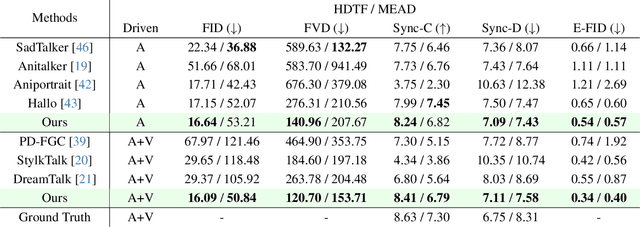
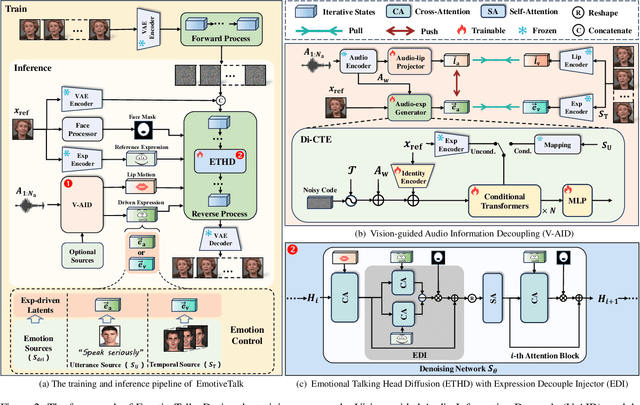


Abstract:Diffusion models have revolutionized the field of talking head generation, yet still face challenges in expressiveness, controllability, and stability in long-time generation. In this research, we propose an EmotiveTalk framework to address these issues. Firstly, to realize better control over the generation of lip movement and facial expression, a Vision-guided Audio Information Decoupling (V-AID) approach is designed to generate audio-based decoupled representations aligned with lip movements and expression. Specifically, to achieve alignment between audio and facial expression representation spaces, we present a Diffusion-based Co-speech Temporal Expansion (Di-CTE) module within V-AID to generate expression-related representations under multi-source emotion condition constraints. Then we propose a well-designed Emotional Talking Head Diffusion (ETHD) backbone to efficiently generate highly expressive talking head videos, which contains an Expression Decoupling Injection (EDI) module to automatically decouple the expressions from reference portraits while integrating the target expression information, achieving more expressive generation performance. Experimental results show that EmotiveTalk can generate expressive talking head videos, ensuring the promised controllability of emotions and stability during long-time generation, yielding state-of-the-art performance compared to existing methods.
ChatGLM: A Family of Large Language Models from GLM-130B to GLM-4 All Tools
Jun 18, 2024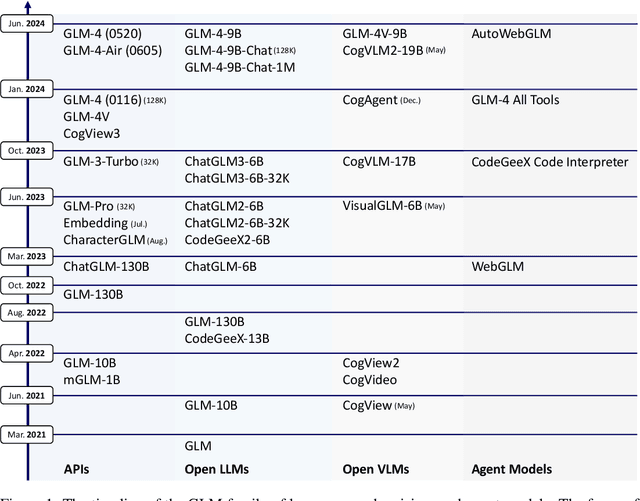
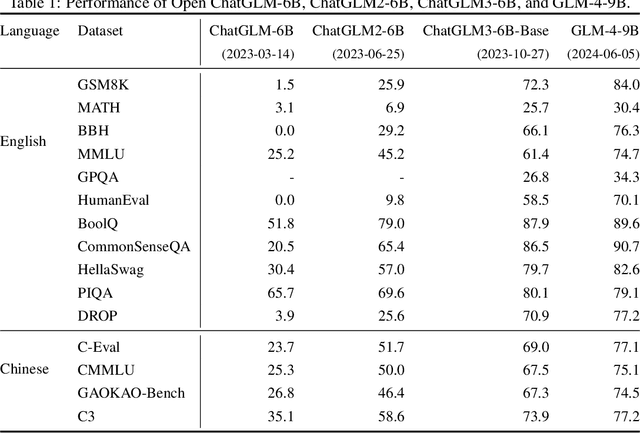
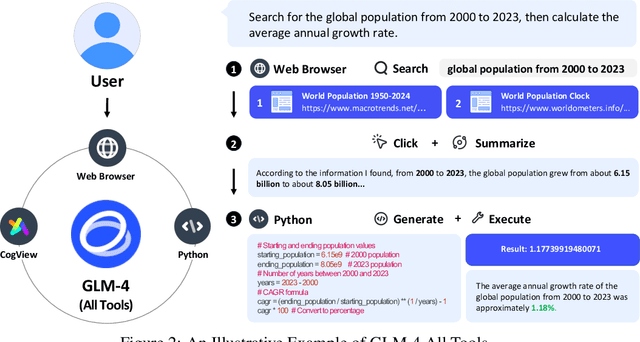
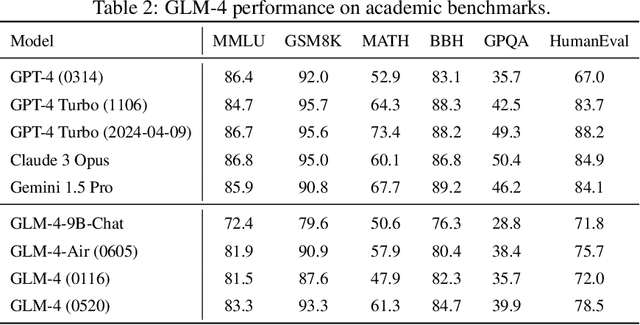
Abstract:We introduce ChatGLM, an evolving family of large language models that we have been developing over time. This report primarily focuses on the GLM-4 language series, which includes GLM-4, GLM-4-Air, and GLM-4-9B. They represent our most capable models that are trained with all the insights and lessons gained from the preceding three generations of ChatGLM. To date, the GLM-4 models are pre-trained on ten trillions of tokens mostly in Chinese and English, along with a small set of corpus from 24 languages, and aligned primarily for Chinese and English usage. The high-quality alignment is achieved via a multi-stage post-training process, which involves supervised fine-tuning and learning from human feedback. Evaluations show that GLM-4 1) closely rivals or outperforms GPT-4 in terms of general metrics such as MMLU, GSM8K, MATH, BBH, GPQA, and HumanEval, 2) gets close to GPT-4-Turbo in instruction following as measured by IFEval, 3) matches GPT-4 Turbo (128K) and Claude 3 for long context tasks, and 4) outperforms GPT-4 in Chinese alignments as measured by AlignBench. The GLM-4 All Tools model is further aligned to understand user intent and autonomously decide when and which tool(s) touse -- including web browser, Python interpreter, text-to-image model, and user-defined functions -- to effectively complete complex tasks. In practical applications, it matches and even surpasses GPT-4 All Tools in tasks like accessing online information via web browsing and solving math problems using Python interpreter. Over the course, we have open-sourced a series of models, including ChatGLM-6B (three generations), GLM-4-9B (128K, 1M), GLM-4V-9B, WebGLM, and CodeGeeX, attracting over 10 million downloads on Hugging face in the year 2023 alone. The open models can be accessed through https://github.com/THUDM and https://huggingface.co/THUDM.
ChatGLM-Math: Improving Math Problem-Solving in Large Language Models with a Self-Critique Pipeline
Apr 03, 2024
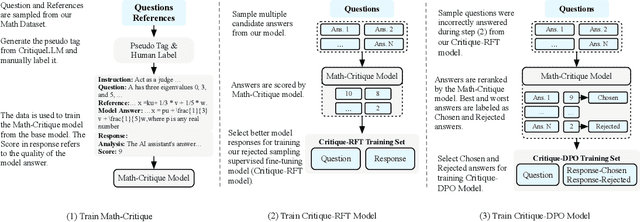


Abstract:Large language models (LLMs) have shown excellent mastering of human language, but still struggle in real-world applications that require mathematical problem-solving. While many strategies and datasets to enhance LLMs' mathematics are developed, it remains a challenge to simultaneously maintain and improve both language and mathematical capabilities in deployed LLM systems.In this work, we tailor the Self-Critique pipeline, which addresses the challenge in the feedback learning stage of LLM alignment. We first train a general Math-Critique model from the LLM itself to provide feedback signals. Then, we sequentially employ rejective fine-tuning and direct preference optimization over the LLM's own generations for data collection. Based on ChatGLM3-32B, we conduct a series of experiments on both academic and our newly created challenging dataset, MathUserEval. Results show that our pipeline significantly enhances the LLM's mathematical problem-solving while still improving its language ability, outperforming LLMs that could be two times larger. Related techniques have been deployed to ChatGLM\footnote{\url{https://chatglm.cn}}, an online serving LLM. Related evaluation dataset and scripts are released at \url{https://github.com/THUDM/ChatGLM-Math}.
 Add to Chrome
Add to Chrome Add to Firefox
Add to Firefox Add to Edge
Add to Edge